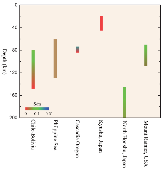Constraints from the dehydration of antigorite on high-conductivity anomalies in subduction zones
- Univ. of Chinese Academy of Sciences, Beijing (China); State Univ. of New York at Stony Brook, Stony Brook, NY (United States)
- Lanzhou Univ., Lanzhou (China)
- Univ. of Chinese Academy of Sciences, Beijing (China)
- Brookhaven National Lab. (BNL), Upton, NY (United States)
- State Univ. of New York at Stony Brook, Stony Brook, NY (United States)
Regions with high electrical conductivities in subduction zones have attracted a great deal of attention. Determining the exact origin of these anomalies could provide critical information about the water storage and cycling processes during subduction. Antigorite is the most important hydrous mineral within deep subduction zones. The dehydration of antigorite is believed to cause high-conductivity anomalies. To date, the effects of dehydration on the electrical conductivity of antigorite remain poorly understood. Here, we report new measurements of the electrical conductivity of both natural and hot-pressed antigorite at pressures of 4 and 3 GPa, respectively, and at temperatures reaching 1073 K. Here, we observed significantly enhanced conductivities when the antigorite was heated to temperatures beyond its thermodynamic stability field. Sharp increases in the electrical conductivity occurred at approximately 848 and 898 K following the decomposition of antigorite to forsterite, enstatite and aqueous fluids. High electrical conductivities reaching 1 S/m can be explained by the presence of an interconnected network of conductive aqueous fluids. Based on these results for the electrical conductivity of antigorite, we conclude that high-conductivity regions associated with subduction zones can be attributed to dehydration-induced fluids and the formation of interconnected networks of aqueous fluids during the dehydration of antigorite.
- Research Organization:
- Research Foundation for the State Univ. of New York, Stony Brook, NY (United States)
- Sponsoring Organization:
- USDOE
- Grant/Contract Number:
- NA0002907
- OSTI ID:
- 1500092
- Journal Information:
- Scientific Reports, Vol. 7, Issue 1; ISSN 2045-2322
- Publisher:
- Nature Publishing GroupCopyright Statement
- Country of Publication:
- United States
- Language:
- English
Web of Science
Anomalous Sound Velocities of Antigorite at High Pressure and Implications for Detecting Serpentinization at Mantle Wedges
|
journal | May 2019 |
Effect of Temperature, Pressure, and Chemical Composition on the Electrical Conductivity of Schist: Implications for Electrical Structures under the Tibetan Plateau
|
journal | March 2019 |
Similar Records
Plasticity of the dense hydrous magnesium silicate phase A at subduction zones conditions
Dehydration-driven stress transfer triggers intermediate-depth earthquakes






